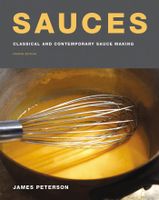Advertisement
Gelatin
Appears in
Published 1991
Well known for its ability to form gels—when done well, delightful gelées that melt as soon as they hit the tongue—gelatin comes in both powdered and sheet form. The sheet form is easier to work with, but given that it’s harder to find, it’s certainly permissible to use the powdered variety.
Derived from animal sources, gelatin sets (and melts) at around body temperature, making it the perfect substance for gels. Gels that melt at a higher temperature (such as those made with agar) may seem sticky and perhaps out of place, but a gelatin gel melts in the mouth. Gelatin should be soaked in cold water and be allowed to bloom before it is added to the hot liquid in which it dissolves. It is used in a wide range of concentrations, but in most cases gelatin solutions should be tested by chilling in the refrigerator to judge their consistency. The gel or, at this point, gelée, should be barely set so it melts in the mouth; it should not be the slightest rubbery.


